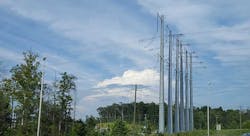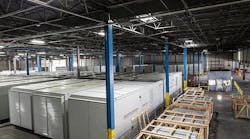The Power Problem: Transmission Issues Slow Data Center Growth
The key to a sustainable digital future isn't new green innovations or AI technology, according to Chris Crosby.
"The number one thing we can do is to build more high-voltage transmission lines," said Crosby. "There are high amounts of (electrical) losses at lower voltage.
"The most critical issue now is transmission," said Crosby, the CEO of Compass Datacenters, in his keynote at the recent Data Center World conference in Austin. "Anyone who says we need more wind and more solar and doesn't also say we need more power lines is being disingenuous. It's a big issue."
The need to upgrade the power grid is a growing priority as the U.S. economy shifts to digital business and electric cars. The data center industry is likely to see slower growth for the next several years as key markets experience delays in power delivery from local utilities. With strong demand and supply of available space at historic lows, data center space is likely to become scarcer and more expensive.
Although America needs more power lines, few people want them in their neighborhood. Efforts to expand transmission capacity often encounter community resistance, and it can take years - and sometimes decades - for major projects to be approved and completed.
The U.S. Department of Energy is seeking ways to address the transmission bottleneck. Last week the DOE said it will work to identify critical transmission needs and use federal funding to accelerate their construction.
“A reliable and resilient electric transmission system is essential to the nation's economic, energy, and national security,” said Maria Robinson, director of the DOE Grid Deployment Office. “We must improve and expand national transmission capacity to meet the challenges of more frequent and intense weather, provide access to diverse sources of clean electricity, and fulfill electricity demands driven by increased electrification of homes, businesses, and vehicles.
Virginia Illustrates Both Sides of the Issue
Transmission bottlenecks became a major story in the data center industry last summer, when Dominion Energy told data center companies that power for some new facilities in Virginia's Loudoun County will be delayed, perhaps until 2026. That has slowed some development around Ashburn, the most active market for cloud computing infrastructure.
In the short-term, Dominion has been analyzing its network and working with customers to provide “incremental” capacity for new projects. For a long-term solution, Dominion is accelerating work on a 500kV transmission line in Southern Loudoun County, which is expected to be completed in 2026 and will relieve many of the transmission bottlenecks that are limiting new connections for data centers in Eastern Loudoun.
"We have fast-tracked transmission projects," said Buddy Rizer, Executive Director, Loudoun County Department of Economic Development. "Thus far it's not nearly as bad as we thought it was going to be. It certainly hasn't hurt demand in Northern Virginia. We have to figure out alternate ways to meet this power demand. It needs to be an 'all of the above' type solution."
A worrisome element of the Virginia transmission issues is that they took the industry and local officials by surprise. Dominion has historically worked closely with the data center industry to gauge demand, but at some point there was a disconnect between projected demand and the transmission capacity to support it.
"No one has really been able to answer that question, and say how it happened," said Rizer. "The week before Dominion said it was out of power, they were issuing 'will serve' letters (for new service connections)."
Northern Virginia also illustrates the reasons why transmission projects can be delayed. A proposal for new power lines to support an Amazon Web Services data center in Prince William led to a bitter four-year controversy, as residents opposed the use of overhead power lines, which Dominion preferred as the most affordable option. The dispute ended in 2018 when Dominion agreed to bury three miles of a power line to support the AWS project in Haymarket.
More Markets Face Power Constraints
Last week CBRE highlighted the power bottlenecks in a market report, noting that they have become a barrier to sustainability initiatives.
"Plans to transition U.S. data centers to renewable energy power sources are impeded by current utility transmission infrastructure," CBRE noted. "The main problems are outdated power lines, delays in planning and permitting for new transmission and distribution projects and supply chain bottlenecks. Upgrading existing transmission lines can take as long as three years, according to the Lawrence Berkeley National Laboratory, due to time-consuming regulatory hurdles, resulting in multi-million-dollar costs."
Aside from Virginia, the most pressing issue is found in Silicon Valley, CBRE said.
"This region has experienced power generation issues due to incredibly high demand for commercial, residential and data center digital infrastructure," the report noted. "On the transmission side, many substation sites will not be energized until 2028-2029 and their timing for coming online may be delayed due to the grid capacity being maxed out in Santa Clara."
One of the nation's cleanest and cheapest energy markets for data centers is also facing constraints, CBRE says the regional power supply in Grant County, Washington is approaching capacity. Grant County is home to a cloud cluster in Quincy, including multiple data centers for Microsoft.
"Plans for 230 kV infrastructure upgrades and a new 230 kV transmission line are underway to increase system reliability and provide incremental capacity to data centers in Grant County," said the CBRE report. "The upgrades are expected to be completed by H2 2028."
Site Selectors Expand Their Field of Vision
CBRE said the fast-growing Dallas market could see relief due to regional regulations. "Texas Senate Bill 1281, passed in 2021, grants new transmission line projects under three miles the right to proceed without the previously required certificate of convenience and necessity (CCN)," CBRE said. "The prior exception maximum was one mile."
As we've noted here at DCF, power constraints in primary markets can create opportunities for regional markets.
"Due to a shortage of power and land, developers are now seeking out new markets that offer similar benefits at a lower cost and with more power available," noted datacenterHawk. "As a result, some companies that were considering Northern Virginia for their requirements are now opting for alternative locations such as Atlanta or Columbus. Similarly, requirements in California are shifting towards cities like Las Vegas, Salt Lake City, or Denver."
"Markets with access to power, such as Atlanta, have been beneficiaries of the Northern Virginia power restrictions," said CBRE. "Atlanta has over 1 GW of new planned capacity."


